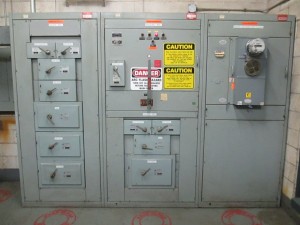 Print a Sign-In Sheet | Spanish Version Coming Soon
Print a Sign-In Sheet | Spanish Version Coming Soon
An arc flash is an explosion caused by a sudden release of energy from an electrical arc. Arc flashes are extremely dangerous and can cause serious injuries.
Arc flashes occur most often in applications above 120 volts when an electrical enclosure or panel is being serviced or inspected. The arc flash is usually caused by accidental contact with energized electrical components.
In many instances injured employees may not be wearing the appropriate personal protective equipment (PPE) thereby exposing their bodies to the intense heat of the arc flash. Other times an employee’s clothing may catch fire resulting in injuries. In addition to posing risks to employees, arc flashes can render equipment unusable.
What should you do?
Employers should perform an arc flash analysis for all equipment locations in their facility. This includes breaker panels, fuse panels, distribution panels, main switch gear branch disconnects, motor control buckets and motor control panels. Such analysis allows employers to determine the arc flash incident energy for that particular location. It also allows employers to determine the size of a potential arc flash explosion, a safe boundary distance, proper warning labels to be posted and the appropriate level of PPE to be worn by employees. Arc flash assessments are typically conducted by outside electrical engineering companies that have the knowledge and expertise to conduct appropriate evaluations. Additionally, these outside companies may offer training so employees understand the arc flash warning label and what levels of PPE are appropriate for each location.
The best practice is to de-energize and lock out any equipment prior to servicing or inspecting it. In instances where working on live (or “hot”) equipment cannot be avoided, an arc flash analysis can determine the best possible scenario for maximizing safety and productivity.
KEMI does not assume liability for the content of information contained herein. Safety and health remain your responsibility. This information is to be used for informational purposes only and not intended to be exhaustive or a substitute for proper training, supervision or manufacturers’ instructions/recommendations. KEMI, by publication of this information, does not assume liability for damage or injury arising from reliance upon it. Compliance with this information is not a guarantee or warranty that you will be in conformity with any laws or regulations nor does it ensure the absolute safety of any person, place or object, including, but not limited to, you, your occupation, employees, customers or place of business.

